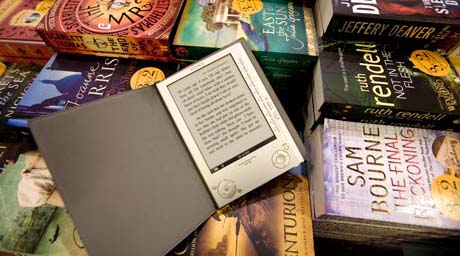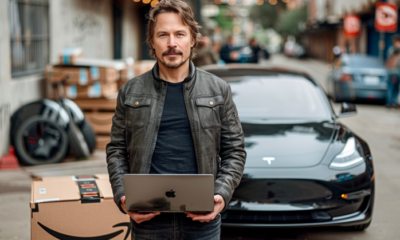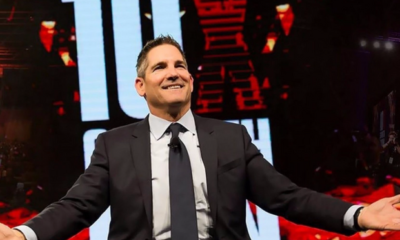Success Advice
8 Ways To Become A Best-Selling Author With Your First Book

I admit it. There are no guarantees—especially with books.
 But while I can’t guarantee this will work for you, I can say it worked for me and I’ll do my best to share why. I’ve published one book (so far) called Mini Habits
But while I can’t guarantee this will work for you, I can say it worked for me and I’ll do my best to share why. I’ve published one book (so far) called Mini Habits, and it’s been a bestseller for more than seven months straight, almost always being in the top 10 of competitive categories. So when I say best seller, I don’t mean that it peaked at #35 in one category one time and dropped back down into oblivion. It has sold 16,000+ copies in these seven months.
At its peak, Mini Habits hit #15 overall in the US Kindle store (and #1 in nonfiction). That was a fun day!
These are the 8 key factors that made my book a best seller. If you’re a current or prospective self-published author, you’ll want to bookmark this one. This is what made my book a mini-phenomenon… one which continues to grow.
1. Give Your Book A Chance To Succeed
Obvious, isn’t it? But how many self-published authors out there are paying enough for skilled editors and talented cover artists? I don’t know the answer, but I know that a lot do NOT invest much money into their book—only their time. The problem with only investing time is that publishing a book takes an alarming number of varied skills to pull off. The likelihood that you can do everything to a high standard is about as likely as North Korea being voted “friendliest country.”
To have a chance, you usually need to take a financial risk. I paid $150 for my first cover. It wasn’t horrible, but I did decide to pay $550 to have another one created that fit the book better and gave a more cheerful vibe. That’s $700 I put into the cover alone. Then you have editing, proofreading, and any other services you might need to fill in your skill gaps.
To compete at a high level in the marketplace, your book must be polished.
2. Launch Big Or Go Home
Book launches are like space shuttle launches—if there’s a problem in the beginning, your entire mission is in big trouble. The reason is a simple, yet powerful observation that any of us can identify as true.
The books that sell are the books that sell.
It’s unfortunate that so many gems are buried in obscurity, but it happens all the time. For your book to have a chance, at some point it must rise up the charts to a place where browsing readers can see it, and the best time for that to happen is right when you release it.
It’s not just visibility, either. Who wants to buy a book that has sold one copy in the past year? Psychologically, we’re wired to think that the books that sell the most are the best ones. That’s not always true, and the way in which it is most incorrect is in assuming books that don’t sell aren’t any good.
Perception and visibility make your book’s success or failure.
How do you launch big?
The most reliable way is with your own targeted email list. I had just over 4,000 email subscribers when I launched Mini Habits. It reached as high as #1,503 overall on Amazon in the first couple of days in which members of my list bought 100-200 copies.
The second best way is with another person’s email list. I was fortunate enough that Steve Scott—a prolific blogger and author—liked the book and shared it with his list of about the same size. This helped minimize the dreaded post-launch cliff and kept it visible.
If you don’t have an email list or know anyone who does, you’ll need to get creative and try to build partnerships with people of influence. One good idea that has worked for some is to give out advance copies of your book to bloggers in your book’s niche. Then ask them to share it if they like it.
The point here is that it’s unrealistic to think your book will sell if it doesn’t have a big push to get it into the spotlight. Just think about a best-selling author like Stephen King—the moment he releases a book, there are already thousands of people waiting to buy it, sending it up the charts and making it visible to even more people. That’s what you need to aim for (on a smaller level, of course). I did it by building a platform (my blog). I’m a poor networker, but I was still able to have a big launch. Play to your strengths and leverage email lists for a big launch! Even if you have to pay someone to advertise to their list, email is the best sales channel.
3. Publish In The Right Place(s)
Mini Habits is exclusive to Amazon. The reason for that is Amazon’s KDP select. There are three benefits of KDP select, which you gain when you only publish your ebook on Amazon.
Countdown sales (or free sales, which I personally think devalues books) — once every 90 days, you can put your book on sale, and there will be a countdown timer to show readers when the sale ends. Most authors find this helps increase sales over manual price changes (because of the official countdown timer).
Prime borrows — Amazon Prime members pay about $99 a year for free two-day shipping on Amazon. As a bonus, they are allowed to borrow one Kindle book per month. If you’re on KDP select, your book is included as an option. On average, Amazon pays you about $2 every time your book is borrowed. Depending on the price of your book, this is almost like another sale. And as for your book’s Amazon ranking, it seems to count as a full or partial sale too, which is obviously wonderful.
Kindle Unlimited — Amazon just announced a Netflix-like subscription model for books. Readers pay $9.99 for unlimited access to more than 600,000 books. Mini Habits is automatically one of those books because it is enrolled in KDP Select. So if a reader has Kindle Unlimited and downloads your book, does it count as a sale? A borrow? It counts as nothing, actually, until they read at least 10% of your book. After they read to the 10% mark, the transaction is counted just like a Prime borrow (which was explained above).
As a side note, guess what Kindle Unlimited is going to encourage? Shorter books, where the 10% mark can be reached more easily. The 10% mark in War And Peace is about the length of my entire book!
Amazon has a KDP fund that is split by authors in KDP select. Your split is determined by what percentage of borrows your book(s) were responsible for. It usually amounts to about $2 per borrow. Now that they’ve added the Kindle Unlimited monkey wrench, the big question is how—if at all—it will affect this $2 per borrow number authors have come to expect. We’ll have to wait and see the first KDP disbursement.
That’s Amazon’s deal and they control 50-60% of the market, so it’s a big deal. It has worked brilliantly for me, and I love the simplicity of only managing one platform. There are legitimate concerns, however, with putting all of your eggs in Amazon’s basket, especially when they’re making industry-shaking moves like Kindle Unlimited. The good news is that if you go exclusive with Amazon, it’s only for 90 days at a time. After that, you’re free to drop KDP select and put your book on other platforms.
I’ve gained thousands of dollars and hundreds of readers by going exclusive with Amazon through the borrows alone, and the Kindle countdown deal is what drove my book to #15 in the USA Kindle store for a few special days. It’s been beneficial to concentrate all sales in one location for sales ranking purposes, too.
That’s not to say it’s best for everyone. I’ve read plenty of authors who get plenty of sales by going multi-platform. I was going to experiment, but it’s gone so well with Amazon that I’ve stuck with it.

4. Make Your Book Relevant, But Unique
I’m not saying you can’t write another vampire book. I’m saying you can’t write “Twi-lite.”
For fiction and nonfiction alike, it’s smart to look at what’s selling well already. That’s where the interest is, and a crowded market is not usually a bad thing. Many people who buy one book in a category will buy several more in that category! Looking at what people are buying now will help you stay relevant.
Now, I’m forever biased, but I think that “Mini Habits” has some intrigue to it. I know it’s at least a unique concept, and yet it’s within the popular habit formation niche (relevant, but unique).
Also important is that “Mini Habits” is a memorable and easily identifiable title, which helps greatly if someone wants to talk about the book or concept with friends. “Mini Habits” is also perfectly descriptive of the book’s topic—I didn’t just throw a catchy name on the cover (though a few copycats of my book did. One guy had “Mini Habits” in the title despite the phrase not being found one time in the actual book… classic).
And that’s another lesson you probably already know. If you want the chance to become a legitimate author yourself, do not blatantly copy other authors. It can work for blog posts to write “The 7 Habits of [blah blah],” but if you publish a book trying to use the same copycat formula, you’ll take a credibility hit.
That said, you can modify a working concept to make it less-than-obvious that you were inspired by a popular book. Maybe your book would be called “The 9 Beliefs Of Very Happy People.” That uses the same general formula as Steven Covey’s blockbuster, “The 7 Habits Of Highly Effective People,” but it’s not a blatant copy and it even tackles a different subject (and it’s a topic in demand as evidenced by other best-selling books on happiness).
The idea is to stay relevant to what people are looking for, but make sure your book stands out. It’s simple advice, but it’s invaluable if you want to sell books!
5. Price Your Book Like A Pro
Note: This strategy applies to Amazon only. I’m not familiar with how the other book markets operate (e.g. Barnes & Noble and Apple).
Just after I launched Mini Habits, I made a mistake. Seeing it as a premium book with premium information, I priced it at a premium price of $9.99. I quickly learned that selling a short book for $10 is a bad idea, especially with your first book. Sales dropped substantially when I increased the price. I expected a drop, but not that much of one! So I lowered it to $5.99, where it’s been selling successfully for months.
To price your ebook, you’ve got to understand the pricing environment you’re in. My book is exclusive with Amazon (and we’ll get to that soon), and so I’ve analyzed the price of hundreds of Amazon ebooks.
People shopping at Amazon have specific expectations of how a book will be priced. Generally what you’ll see is self-published ebooks in the $2.99-9.99 range (with almost all at or below $5.99) and traditionally-published ebooks are often greater than $10. Since Amazon gives a 70% royalty for ebooks in the 2.99-9.99 range, that’s why you see so many books between those boundaries. Books priced outside that range only earn a 35% royalty for the author.
If you “fight the market” and stubbornly price your book at $15 “because it’s worth it,” enjoy having no sales! If you’re like me and you cringe a little bit at selling your baby for too little, consider the other great thing you get from a lower price point—readers! Writers need readers, right? And generally speaking, gaining a loyal reader is more valuable than making a couple bucks more per sale. So if you’re going to be a rebel, choose another way besides pricing. Believe me, you want to conform to market pricing.
6. Categorize Your Book Like A Pro
Let me ask you a question. After you launch your book and place it in the proper categories, what do you do? If you said anything besides “change categories,” listen to this. When I made a change to ONE category Mini Habits was in (you can put your book in two categories), sales doubled. That needs all caps, doesn’t it? SALES DOUBLED.
To properly categorize your book, there are only two factors to consider—where your book ranks in the category and how well it sells there. Generally speaking, my strategy is to get in the most popular category where I can rank well. For my sales volume now, that means a popular category in which I can get on the first page (top 20 books). For someone just starting out with lower sales or a very competitive niche (e.g. Mystery), you might be aiming to break the top 100, which is where the bestseller list cuts off.
Keep in mind that being #83 in a popular category might get much more traffic than being the top 20 of a less popular category. Fiction readers especially are voracious, and will scour the deepest depths of their favorite categories to find a new gem.
To get an idea of a category’s popularity, look at several of the first 20 books. Click on a book and scroll down until you see its overall ranking. If it’s a competitive category, you’ll see several books rank in the top 1,000 books overall. If it’s not a very competitive category, the #1 book might be ranked as low as #5,000-#15,000 overall. Now find your book’s overall ranking to see where it would be in the category you’re analyzing.
These should be your priorities:
- Break top 100 in a category
- Break top 20 in a category (first page)
- Become #1 in a category (this might help with Amazon’s system recommendations, and Amazon shows “#1 best seller in ____” next to your book in search)
You have to think carefully though. Being #3 in a popular category will most likely serve you better than being #1 in a lower-traffic category, but only experimentation can confirm this. I’ve had the best results by jumping into a popular category when my book can rank in the top 20, and when I can’t manage that, jumping down to a less popular category and aiming for the top 5.
Chances are, your book can fit in a number of different categories. Some categories are better fits for your book than others, but choosing the “best fit” is not always the best decision for getting your book more sales and exposure. That said, if you pick a completely irrelevant category, you won’t be happy with the results!
These are good guidelines to follow, but you’ll still need to experiment. And that’s the key. Many authors do not experiment, and let their book die young in the wrong category. Sometimes I wonder where Mini Habits would be if I didn’t experiment with categories.

7. Know Your Reader And Overdeliver On Value
When people read Mini Habits, they probably expect to think, “that was a cute idea,” or some adorable phrase like that. But what they get is a compelling and carefully-crafted case for taking seriously this ridiculous-sounding strategy of habit change. I loaded the book with science and straightforward logic. I also know the strategies people currently try to succeed with, so I effectively and ruthlessly attacked them as inferior strategies for change. If you’ve been doing something for 25 years and a person presents a compelling case for why you shouldn’t do it anymore, it will get your attention.
After reading my book, people come away with a new perspective. For many of the people who’ve read it, it’s been a life-changing decision for them. That’s why Mini Habits is rated 4.7 stars from 197 reviews as of writing. I’m not trying to brag, I’m trying to explain that people have to like your book in order for it to succeed. But what determines that?
Give the reader tangible results.
Whether it’s a fun experience or a new strategy that solves a problem for them, delivering a result that meets—and hopefully exceeds—what the reader expects from your book is the single most important thing your book must accomplish to succeed.
If your book only rehashes things that have been said and done before, it’s unlikely to make too many waves. One of the most common critical reviews I see is, “nothing new.” That happens when people don’t do in-depth research. They parrot out what other authors are parroting out.
Readers like to be surprised by novel situations in fiction books and novel ideas in nonfiction books. They read books to learn and experience new thoughts and ideas, and if your book doesn’t accomplish that, it will be tough to win people over.
But I want to go a little bit deeper. Overdelivering isn’t just some fancy catchphrase that means “do a good job.” It means to “do more than what’s expected.” And this is critical with books because expectations are largely based the price of your book and how the content measures up to the competition—two things that you can control. We just talked about overdelivering and standing out, so now let’s talk pricing and categories.
8. Promote The Smart Way
Note: Some authors will cheat the system and buy positive reviews. People read reviews to see what real people thought of your book. If you can’t get ahead without cheating, you should play a different game! That’s my philosophy, and I think that the trust I build with my book and blog readers will be THE key factor that sustains my business. Not only is review tampering highly unethical, but I find it unnecessary.
Cheating gets you ahead today; honesty builds a foundation for life. It feels good to know that people will look at Mini Habits’ reviews and see nothing but honest feedback. Fortunately, the feedback has been positive, and that’s why overdelivering is important.
Mini Habits has sold like hotcakes for 7 months in a row. Why do you think that is? Whenever sales drop, and even when they don’t, I’m hustling to promote it! Writing and publishing a book is only the beginning. Promotion is a neverending job because when you stop promoting, your book will fade away (unless it’s a rare exception).
Too many authors write a book and wait for the sales to come, but in order to compete, marketing your book is mandatory.
For promotion, the king on top of the mountain is Bookbub. There is no arguing against it, and their role in the book industry is only going to grow moving forward. Bookbub is a book deal site that has email lists of hundreds of thousands of subscribers in different categories. They let subscribers know when there’s a great deal on a great book.
Remember how I said the email list was the key to a big launch? That’s why Bookbub is king. They have, by far, the largest email lists of interested readers (for example, they have 1.5 million emails for the Mystery category alone)!
If you submit your book and are lucky enough to be accepted, you get to pay them several hundred dollars. Wha-whaaat? Yes, and if you know what you’re in for, you’ll have a huge smile on your face when you do it. I often read message boards and laugh when people say Bookbub and “risk” in the same sentence because of the cost. I’ve not heard of one person who hasn’t easily covered their cost with a Bookbub promotion. One measly email from them will trigger hundreds or thousands of sales of your book.
I didn’t mention this, but do you know how Mini Habits rose to #15 overall? It sold 4,000+ copies in two days. And it wasn’t just the Kindle countdown deal, it was Bookbub. And the residual effect of moving up the charts like that is substantial. Sales are still higher months after the promotion, because the books that sell are the books that sell.
But it’s difficult to be accepted on Bookbub because of the demand, and you can understand why. Getting on Bookbub with a diamond in the rough book might just change your life. It changed mine!
If you think the whole point of this article is “get on Bookbub,” that’s not correct. You can absolutely succeed without Bookbub, and your book will need to be somewhat successful already in order to have a chance with them anyway. Keep in mind that the reason they accepted Mini Habits is that it was already selling well, was rated 4.9 stars, and it had that combination of unique, but relevant I mentioned earlier. Bookbub just took my book’s success to the next level.
Bookbub isn’t the only one, either. There are dozens of other ebook promotion services. Many of them will give you disappointing results, so be careful and google “[their name] results” to see others’ experiences with them. I’ve found this to be a reliable way to see if a promotion is worth it or not. I’ll go ahead and tell you that Pixel of Ink and eReaderNewsToday are the other two to look at first.
Alternative Promotion Strategies
Guest posting—I’ve had success with guest posting and linking to my book in my bio. As expected, it works best when the post is related to the topic of your book. This is easier for non-fiction writers, since the content is suitable for a larger number of blogs.
Funnels—This isn’t a “best-selling first book” approach because it requires multiple books, but many authors have success with funnels. An example of a funnel is having the first book in a series free, which draws in a larger amount of people than a for-sale book would. Then, the second book in the series might cost $2.99, and readers who get “hooked” on the first book will likely purchase the second book. After that, maybe you’ll sell them an even higher priced book or related product. The idea of a funnel is to ask for very little at first until you build trust with the reader. If your books are good, it works very well. If people read your first book and hate it, well, you know…
Advertising—Conventional advertising with Google adwords or Facebook is always an option. I don’t do it, but it’s another way to get sales and increase awareness of your book. Just keep a close eye on your ROI, because losing a lot of money for a few sales isn’t ideal.
Goodreads – You must get on Goodreads if you’re an author. It’s like the world’s biggest book club. I’ve run two paperback giveaways through Goodreads, and I can’t say it’s done a lot for sales, but I don’t know that for sure. It has greatly increased my presence on Goodreads, which can only help. My guess is that it’s had a small-to-moderate positive long term impact on sales (but no short-term sales boosts).
Conclusion
The truth is that most authors give their books absolutely no chance to rise to the top. First, position your book to succeed, and it will have a chance to be read. If it’s read and people love it, it might just become the next blockbuster. But don’t let that get you too excited or discouraged—there’s a middle ground. There are a lot of authors just like me who aren’t in the paper, but are still making a decent living from their book(s).
Unlike any time before now, every writer has a chance. The gatekeepers have been overthrown with the rise of self-publishing. Now it’s the wild west, and these strategies will help you compete.
Business
If Your Business Internet Keeps Letting You Down, Read This
From smoother operations to better security, dedicated internet access is quietly powering today’s high-performing businesses.

Today, a dependable internet service is the bedrock for uninterrupted business operations. Many organizations rely on stable online connections for communication, data transfer, and customer interaction. (more…)
Did You Know
How Skilled Migrants Are Building Successful Careers After Moving Countries
Behind every successful skilled migrant career is a mix of resilience, strategy, and navigating systems built for locals.

Moving to a new country for work is exciting, but it can also be unnerving. Skilled migrants leave behind familiar systems, networks, and support to pursue better job opportunities and a better future for their families. (more…)
Life
10 Research-Backed Steps to Create Real Change This New Year
This New Year could finally be the one where you break old patterns and create real, lasting change.

Every New Year, we make plans and set goals, but often repeat old patterns. (more…)
Change Your Mindset
The Silent Skill That Makes People Respect You Instantly
What truly earns respect and why most people go about it the wrong way

Everybody craves respect but not everyone earns it. Some people believe that a title, years of experience, or a position of authority automatically entitles them to respect. (more…)
-

 Did You Know4 weeks ago
Did You Know4 weeks agoHow Skilled Migrants Are Building Successful Careers After Moving Countries
-

 Health & Fitness2 days ago
Health & Fitness2 days agoWhat Minimalism Actually Means for Your Wellness Choices
-

 Business1 day ago
Business1 day agoIf Your Business Internet Keeps Letting You Down, Read This
-

 Did You Know14 hours ago
Did You Know14 hours agoWhy Most Online Courses Fail and How to Fix Them


























11 Comments